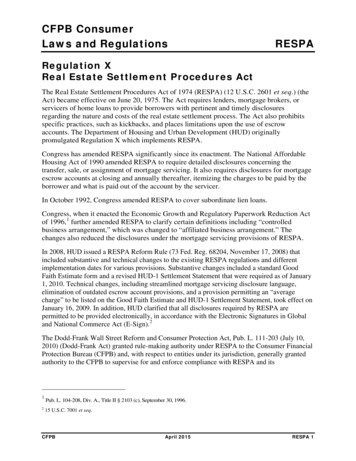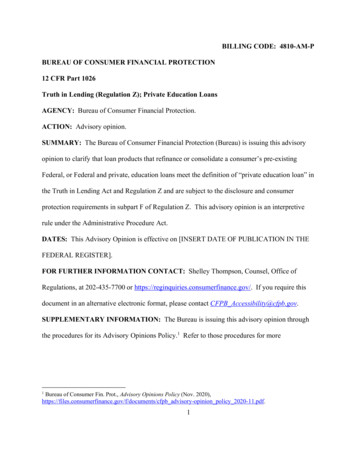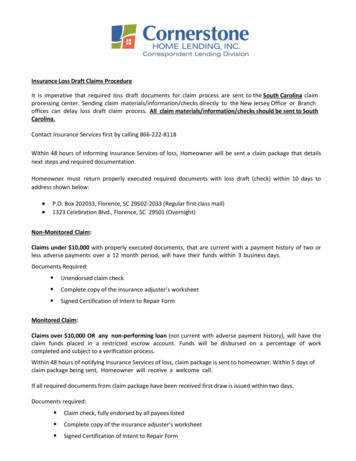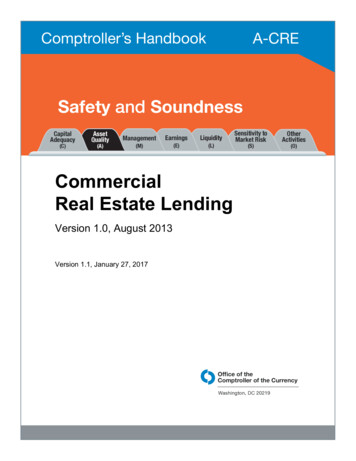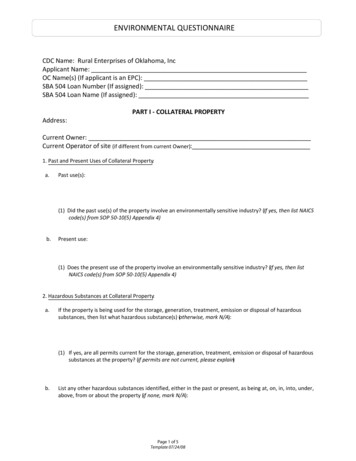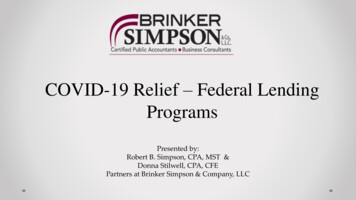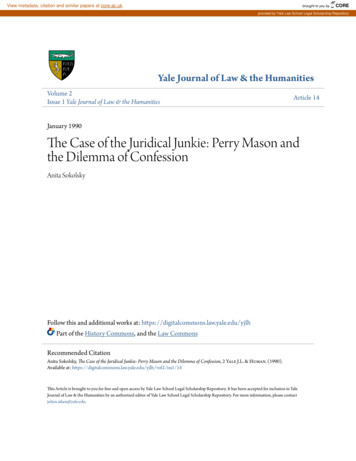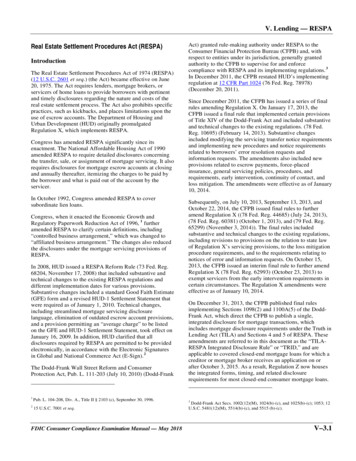
Transcription
V. Lending — RESPAReal Estate Settlement Procedures Act (RESPA)IntroductionThe Real Estate Settlement Procedures Act of 1974 (RESPA)(12 U.S.C. 2601 et seq.) (the Act) became effective on June20, 1975. The Act requires lenders, mortgage brokers, orservicers of home loans to provide borrowers with pertinentand timely disclosures regarding the nature and costs of thereal estate settlement process. The Act also prohibits specificpractices, such as kickbacks, and places limitations upon theuse of escrow accounts. The Department of Housing andUrban Development (HUD) originally promulgatedRegulation X, which implements RESPA.Congress has amended RESPA significantly since itsenactment. The National Affordable Housing Act of 1990amended RESPA to require detailed disclosures concerningthe transfer, sale, or assignment of mortgage servicing. It alsorequires disclosures for mortgage escrow accounts at closingand annually thereafter, itemizing the charges to be paid bythe borrower and what is paid out of the account by theservicer.In October 1992, Congress amended RESPA to coversubordinate lien loans.Congress, when it enacted the Economic Growth andRegulatory Paperwork Reduction Act of 1996, 1 furtheramended RESPA to clarify certain definitions, including“controlled business arrangement,” which was changed to“affiliated business arrangement.” The changes also reducedthe disclosures under the mortgage servicing provisions ofRESPA.In 2008, HUD issued a RESPA Reform Rule (73 Fed. Reg.68204, November 17, 2008) that included substantive andtechnical changes to the existing RESPA regulations anddifferent implementation dates for various provisions.Substantive changes included a standard Good Faith Estimate(GFE) form and a revised HUD-1 Settlement Statement thatwere required as of January 1, 2010. Technical changes,including streamlined mortgage servicing disclosurelanguage, elimination of outdated escrow account provisions,and a provision permitting an “average charge” to be listedon the GFE and HUD-1 Settlement Statement, took effect onJanuary 16, 2009. In addition, HUD clarified that alldisclosures required by RESPA are permitted to be providedelectronically, in accordance with the Electronic Signaturesin Global and National Commerce Act (E-Sign). 2The Dodd-Frank Wall Street Reform and ConsumerProtection Act, Pub. L. 111-203 (July 10, 2010) (Dodd-Frank1Pub. L. 104-208, Div. A., Title II § 2103 (c), September 30, 1996.215 U.S.C. 7001 et seq.FDIC Consumer Compliance Examination Manual — May 2018Act) granted rule-making authority under RESPA to theConsumer Financial Protection Bureau (CFPB) and, withrespect to entities under its jurisdiction, generally grantedauthority to the CFPB to supervise for and enforcecompliance with RESPA and its implementing regulations. 3In December 2011, the CFPB restated HUD’s implementingregulation at 12 CFR Part 1024 (76 Fed. Reg. 78978)(December 20, 2011).Since December 2011, the CFPB has issued a series of finalrules amending Regulation X. On January 17, 2013, theCFPB issued a final rule that implemented certain provisionsof Title XIV of the Dodd-Frank Act and included substantiveand technical changes to the existing regulations. (78 Fed.Reg. 10695) (February 14, 2013). Substantive changesincluded modifying the servicing transfer notice requirementsand implementing new procedures and notice requirementsrelated to borrowers’ error resolution requests andinformation requests. The amendments also included newprovisions related to escrow payments, force-placedinsurance, general servicing policies, procedures, andrequirements, early intervention, continuity of contact, andloss mitigation. The amendments were effective as of January10, 2014.Subsequently, on July 10, 2013, September 13, 2013, andOctober 22, 2014, the CFPB issued final rules to furtheramend Regulation X ((78 Fed. Reg. 44685) (July 24, 2013),(78 Fed. Reg. 60381) (October 1, 2013), and (79 Fed. Reg.65299) (November 3, 2014)). The final rules includedsubstantive and technical changes to the existing regulations,including revisions to provisions on the relation to state lawof Regulation X’s servicing provisions, to the loss mitigationprocedure requirements, and to the requirements relating tonotices of error and information requests. On October 15,2013, the CFPB issued an interim final rule to further amendRegulation X (78 Fed. Reg. 62993) (October 23, 2013) toexempt servicers from the early intervention requirements incertain circumstances. The Regulation X amendments wereeffective as of January 10, 2014.On December 31, 2013, the CFPB published final rulesimplementing Sections 1098(2) and 1100A(5) of the DoddFrank Act, which direct the CFPB to publish a single,integrated disclosure for mortgage transactions, whichincludes mortgage disclosure requirements under the Truth inLending Act (TILA) and Sections 4 and 5 of RESPA. Theseamendments are referred to in this document as the “TILARESPA Integrated Disclosure Rule” or “TRID,” and areapplicable to covered closed-end mortgage loans for which acreditor or mortgage broker receives an application on orafter October 3, 2015. As a result, Regulation Z now housesthe integrated forms, timing, and related disclosurerequirements for most closed-end consumer mortgage loans.3Dodd-Frank Act Secs. 1002(12)(M), 1024(b)-(c), and 1025(b)-(c); 1053; 12U.S.C. 5481(12)(M), 5514(b)-(c), and 5515 (b)-(c).V–3.1
V. Lending — RESPAThe new integrated disclosures are not used to discloseinformation about reverse mortgages, home equity lines ofcredit (HELOCs), chattel-dwelling loans such as loanssecured by a mobile home or by a dwelling that is notattached to real property (i.e., land), or other transactions notcovered by the TILA-RESPA Integrated Disclosure Rule.The final rule also does not apply to loans made by a creditorwho makes five or fewer mortgages in a year. Creditorsoriginating these types of mortgages must continue to use, asapplicable, the GFE, HUD-1 Settlement Statement, and Truthin Lending (TIL) disclosures.On August 4, 2016, the CFPB issued a final rule to furtherclarify, revise, and amend provisions of Regulation X as wellas Regulation Z, the regulation implementing TILA. (81 Fed.Reg. 72160) (October 19, 2016). The amendments in thefinal rule are referenced in this document as the “2016Servicing Rule.” The 2016 Servicing Rule establishes adefinition of successor in interest and provides thatconfirmed successors in interest are considered “borrowers”for the purposes of Regulation X’s mortgage servicingprovisions. Confirmed successor in interest means asuccessor in interest once a servicer has confirmed thesuccessor in interest’s identity and ownership interest in aproperty that secures a mortgage loan subject to Subpart C ofRegulation X. The 2016 Servicing Rule also addressescompliance with certain servicing requirements when aperson is a debtor in bankruptcy or sends a ceasecommunication request under the Fair Debt CollectionPractices Act (FDCPA).Additionally, the 2016 Servicing Rule clarifies, revises, oramends provisions regarding force-placed insurance notices,policy and procedure requirements, early intervention, andloss mitigation requirements under Regulation X’s mortgageservicing provisions; and which loans are considered indetermining whether a servicer qualifies as a small servicer,certain periodic statement requirements relating tobankruptcy and charge-off, and prompt creditingrequirements under Regulation Z’s mortgage servicingprovisions. The 2016 Servicing Rule was effective October19, 2017, except for the provisions related to successors ininterest and periodic statements for borrowers in bankruptcy,which take effect on April 19, 2018.and provides safe harbors from liability for servicers acting incompliance with it.On October 4, 2017, the CFPB issued an interim final ruleamending a provision of the 2016 Servicing Rule relating tothe timing for servicers to provide modified written earlyintervention notices under Regulation X to borrowers whohave invoked their cease communication rights under theFDCPA. (82 FR 47953) (October 16, 2017). The interim finalrule was effective October 19, 2017.Subpart A – General ProvisionsCoverage – 12 CFR 1024.5(a)RESPA is applicable to all “federally related mortgageloans,” except as provided under 12 CFR 1024.5(b) and1024.5(d), discussed below. “Federally related mortgageloans” are defined as:Loans (other than temporary loans), including refinancingsthat satisfy the following two criteria: The CFPB concurrently issued an interpretive rule under theFDCPA to clarify the interaction of the FDCPA and specifiedmortgage servicing rules in Regulations X and Z. (81 Fed.Reg. 71977) (October 19, 2016). 4 This interpretive ruleconstitutes an advisory opinion for purposes of the FDCPAFirst, the loan is secured by a first or subordinate lien onresidential real property, located within a state, uponwhich either:oA one-to-four family structure is located or is to beconstructed using proceeds of the loan (includingindividual units of condominiums and cooperatives);oroA manufactured home is located or is to beconstructed using proceeds of the loan.Second, the loan falls within one of the followingcategories:oLoans made by a lender, 5 creditor, 6 dealer; 7oLoans made or insured by an agency of the federalgovernment;oLoans made in connection with a housing or urbandevelopment program administered by an agency ofthe federal government;5A lender includes financial institutions either regulated by, or whosedeposits or accounts are insured by, any agency of the federal government.64See Safe Harbors from Liability under the Fair Debt Collection PracticesAct for Certain Actions Taken in Compliance with Mortgage Servicing Rulesunder the Real Estate Settlement Procedures Act (Regulation X) and theTruth in Lending Act (Regulation Z) (81 Fed. Reg. 71977) (Oct. 19, 2016)(hereinafter 2016 FDCPA Interpretive Rule). The interpretations contained inthis interpretive rule are included in Regulation X comments 30(d)-1 and39(d)-2; Regulation Z comment 2(a)(11)-4.ii.V–3.2A creditor is defined in Section 103(g) of the Consumer Credit ProtectionAct (15 U.S.C. 1602(g)). RESPA covers any creditor that makes or invests inresidential real estate loans aggregating more than 1,000,000 per year.7“Dealer” is defined in Regulation X to mean a seller, contractor, or supplierof goods or services. Dealer loans are covered by RESPA if the obligationsare to be assigned before the first payment is due to any lender or creditorotherwise subject to the regulation.FDIC Consumer Compliance Examination Manual — May 2018
V. Lending — RESPAoLoans made and intended to be sold by theoriginating lender or creditor to FNMA, GNMA, orFHLMC (or its successor); 8 oroLoans that are the subject of a home equityconversion mortgage or reverse mortgage issued bya lender or creditor subject to the regulation.instrument, as long as a new note is not required, even ifthe lender charges an additional fee for the conversion. 9 “Federally related mortgage loans” are also defined toinclude installment sales contracts, land contracts, orcontracts for deeds on otherwise qualifying residentialproperty if the contract is funded in whole or in part byproceeds of a loan made by a lender, specified federalagency, dealer or creditor subject to the regulation.Exemptions – 12 CFR 1024.5(b)The following transactions are exempt from coverage: A loan primarily for business, commercial oragricultural purposes (definition identical to RegulationZ, 12 CFR 1026.3(a)(1)). A temporary loan, such as a construction loan. (Theexemption does not apply if the loan is used as, or maybe converted to, permanent financing by the samefinancial institution or is used to finance transfer of titleto the first user of the property.) If the lender issues acommitment for permanent financing, it is covered bythe regulation. Any construction loan with a term of two years or moreis covered by the regulation, unless it is made to a bonafide contractor. “Bridge” or “swing” loans are notcovered by the regulation.Partial Exemptions for Certain Mortgage Loans – 12CFR 1024.5(d)Most closed-end mortgage loans are exempt from therequirement to provide the GFE, HUD-1 settlementstatement, and application servicing disclosure requirementsof 12 CFR 1024.6, 1024.7, 1024.8, 1024.10, and 1024.33(a).Instead, these loans are subject to disclosure, timing, andother requirements under TILA and Regulation Z.Specifically, the aforementioned provisions do not apply to afederally related mortgage loan that: Is subject to the special disclosure (TILA-RESPAIntegrated Disclosure) requirements for certain consumercredit transactions secured by real property set forth inRegulation Z, 12 CFR 1026.19(e), (f), and (g); or Is subject to the partial exemption under 12 CFR1026.3(h) (i.e., certain no-interest loans secured bysubordinate liens made for the purpose of down paymentor similar home buyer assistance, property rehabilitation,energy efficiency, or foreclosure avoidance orprevention. (12 CFR 1026.3(h)).A loan secured by vacant or unimproved property whereno proceeds of the loan will be used to construct a oneto-four family residential structure. If the proceeds willbe used to locate a manufactured home or construct astructure within two years from the date of settlement,the loan is covered. An assumption, unless the mortgage instruments requirelender approval for the assumption and the lenderapproves the assumption. A conversion of a loan to different terms which areconsistent with provisions of the original mortgageNOTE: A creditor may not use the TILA-RESPAIntegrated Disclosure forms instead of the GFE, HUD-1,and TIL forms for transactions that continue to becovered by TILA or RESPA that require thosedisclosures (e.g., reverse mortgages). 1098FNMA – Federal National Mortgage Association; GNMA - GovernmentNational Mortgage Association; FHLMC – Federal Home Loan MortgageCorporation.FDIC Consumer Compliance Examination Manual — May 2018A bona fide transfer of a loan obligation in the secondarymarket. (However, the mortgage servicing requirementsof Subpart C, 12 CFR 1024.30-41, still apply.) Mortgagebroker transactions that are table funded (the loan isfunded by a contemporaneous advance of loan funds andan assignment of the loan to the person advancing thefunds) are not secondary market transactions andtherefore are covered by RESPA. Similarly, neither thecreation of a dealer loan or consumer credit contract, northe first assignment of such loan or contract to a lender,is a secondary market transaction.12 CFR 1024.5(b)(6).10Open-end reverse mortgages receive open-end disclosures, rather thanGFEs or HUD-1s.V–3.3
V. Lending — RESPASummary of Applicable Disclosure Requirements:Use TILA-RESPA Integrated Disclosures (SeeRegulation Z): Most closed-end mortgage loans, including:o Construction-only loanso Loans secured by vacant land or by 25 ormore acresContinue to use existing TIL, RESPA Disclosures (asapplicable): HELOCs (subject to disclosure requirementsunder Regulation Z, 12 CFR 1026.40) Reverse mortgages (subject to existing TILand GFE disclosures) Chattel-secured mortgages (i.e., mortgagessecured by a mobile home or by a dwellingthat is not attached to real property, such asland) (subject to existing TIL disclosures, andnot RESPA)But note: In both cases, there is a partial exemption from these disclosures under 12 CFR 1026.3(h) for loanssecured by subordinate liens and associated with certain housing assistance loan programs for low- andmoderate-income persons.Subpart B – Mortgage Settlement and EscrowAccountsExaminers should note that certain provisions in Subpart B(12 CFR 1024.6, 1024.7, 1024.8, and 1024.10) are applicableonly to limited categories of mortgage loans. See thediscussion of 12 CFR 1024.5(d) above.Special Information Booklet – 12 CFR 1024.6For mortgage loans that are not subject to the TILA-RESPAIntegrated Disclosure Rule (see 12 CFR 1026.19(e), (f) and(g)),* a loan originator 11 is required to provide the borrowerwith a copy of the Special Information Booklet at the time awritten application is submitted or no later than threebusiness days after the application is received. If theapplication is denied before the end of the three-business-dayperiod, the loan originator is not required to provide thebooklet. If the borrower uses a mortgage broker, the brokerrather than the lender, must provide the booklet.The booklet does not need to be provided for refinancingtransactions, closed-end subordinate lien mortgage loans andreverse mortgage transactions, or for any other federallyrelated mortgage loan not intended for the purchase of a oneto-four family residential property. (12 CFR1024.19(g)(1)(iii)).A loan originator that complies with Regulation Z (12 CFR11A “loan originator” is defined as a lender or mortgage broker. 12CFR 1024.2(b).V–3.41026.40) for open-end home equity plans (including providingthe brochure entitled “What You Should Know About HomeEquity Lines of Credit” or a suitable substitute) is deemed tohave complied with this section.NOTE: The Special Information Booklet may also be requiredunder 12 CFR 1026.19(g) for those closed-end mortgage loanssubject to the TILA-RESPA Integrated Disclosure Rule. Adiscussion of those requirements is located in the Regulation Zexamination procedures.Good Faith Estimate (GFE) of Settlement Costs –12 CFR 1024.7 Standard GFE RequiredFor closed-end reverse mortgages, a loan originator isrequired to provide a consumer with the standard GFEform that is designed to allow borrowers to shop for amortgage loan by comparing settlement costs and loanterms. (See GFE form at Appendix C to 12 CFR Part1024.)Overview of the Standard GFEThe first page of the GFE includes a summary of loan termsand a summary of estimated settlement charges. It alsoincludes information about key dates such as when theinterest rate for the loan quoted in the GFE expires and whenthe estimate for the settlement charges expires. The secondpage discloses settlement charges as subtotals for 11categories of costs. The third page provides a tableexplaining which charges can change at settlement, a tradeoff table showing the relationship between the interest rateand settlement charges, and a shopping chart to compare thecosts and terms of loans offered by different originators.FDIC Consumer Compliance Examination Manual — May 2018
V. Lending — RESPAapplication or information sufficient to complete anapplication. The lender is responsible for ascertainingwhether the GFE has been provided. If the mortgagebroker has provided the GFE to the applicant, the lenderis not required to provide an additional GFE.GFE Application Requirements The loan originator must provide the standard GFE tothe borrower within three business days of receipt of anapplication for a mortgage loan. A loan originator is notrequired to provide a GFE if before the end of the threebusiness-day period, the application is denied or theborrower withdraws the application.An application can be in writing or electronicallysubmitted, including a written record of an oralapplication.A loan originator determines what information it needsto collect from a borrower and which of the collectedinformation it will use in order to issue a GFE. Underthe regulations, an “application” includes at least thefollowing six pieces of information:1)The borrower’s name;2)The borrower’s gross monthly income;3)The borrower’s Social Security number (e.g., toenable the loan originator to obtain a credit report);4)The property address;5)An estimate of the value of the property; and6)The mortgage loan amount sought. In addition, aloan originator may require the submission of anyother information it deems necessary.A loan originator will be presumed to have relied onsuch information prior to issuing a GFE and cannot basea revision of a GFE on that information unless it changesor is later found to be inaccurate. While the loan originator m
Truth in Lending Act (Regulation Z) (81 Fed. Reg. 71977) (Oct. 19, 2016) (hereinafter 2016 FDCPA Interpretive Rule). The interpretations contained in this interpretive rule are included in Regulation X comments 30(d)-1 and 39(d)-2; Regulation Z. comment 2(a)(11)-4.ii. and provides safe harbors from liability for servicers acting in compliance .
